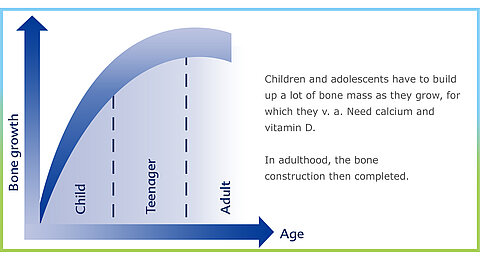Vitamin D for strong bones

Young children are discovering the world and becoming more active every day. Vitamin D is important for healthy development in the growth phase. Along with calcium, vitamin D plays a key role in bone metabolism and stimulates the development of healthy bones.
However, recent studies indicate insufficient vitamin D intake in children and adolescents.
Vitamin D – the sun vitamin

Vitamin D is the only vitamin our body can produce in the skin. However, for vitamin D to form, our skin needs to be exposed to sunlight. Hence its name "vitamin of the sun".
Approximately 80 - 90% of the required vitamin D is produced by the skin. Only 10-20% is obtained by food.
In the case of children, who are protected by a high sun protection factor (> SPF 15), even in summer, it prevents them from absorbing vitamin D, causing their level to decrease more and more over time. However, vitamin D is also important for adults. Foods usually supply insufficient amounts of this vitamin, and as with children, the level of vitamin D drops in winter. It is estimated that approximately 65% of the population is vitamin D deficient.
Importance of Vitamin D

Children and young people need to build up a lot of bone mass while they are growing up. The first 20 years of life are when the body generates the most bone mass. Only those who develop strong bones in childhood will be able to use them fully as adults.
Calcium and vitamin D are important for building strong bones. Calcium serves as a building block for bones. Vitamin D is important for the normal development of bones and teeth. Vitamin D is also involved in other metabolic processes in the body and has an impact on the immune system.
For this reason, babies are given a vitamin D supplement in the form of drops in combination with breast milk and/or infant formula, because a lack of vitamin D in infancy/childhood may involve the health risk of rickets. It is recommended to take it until the second summer of the child's life.
The child is still growing and building up bone mass long after that. However, many parents do not like the idea of giving a child drops every day after this "supplementation phase". That's why the supply of extra vitamin D is usually ignored. But vitamin D remains essential throughout the growth phase.
This is why babies receive a vitamin D supplement in the form of drops in combination with breast milk and / or infant formula, because a lack of vitamin D in infancy / childhood could carry the risk of rickets. It is recommended to take it until the second summer of the child's life.
The child is still growing and accumulating bone mass long after that. However, many parents do not like the idea of giving a child drops every day after this "supplementation phase." That is why the supply of additional vitamin D is generally ignored. But vitamin D remains essential throughout the growth phase.
The main sources of vitamin D

Vitamin D is obtained in two ways. Most of it is produced in the skin. The amount depends on the duration and intensity of the sunlight. Sun protection, such as covering the skin with clothing or limited sunlight in the winter months, also reduces vitamin D production.
In addition, foods containing vitamin D can help supply it. However, there are few foods that contain significant amounts of vitamin D, such as oily fish (e.g., herring, salmon). Liver, egg yolk and some edible mushrooms, the content is considerably lower. On average, only 2-4 µg of vitamin D is obtained from food.
HiPP Organic Combiotic growing up formulas are an option to complement your baby's diet as they are fortified with Vitamins and Minerals (including Vitamin D) specific to your little one's age and life stage.
Sources:
1. Thierfelder W et al. (2007) Biochemical measures in the German Health Interview and Examination Survey for Children and Adolescents (KiGGS). Bundesgesundheitsblatt Gesundheitsforschung Gesundheitsschutz 50(5-6):757-770.
2. Hower J (2008) Winterlicher Vitamin D-Mangel bei Kindern und Jugendlichen. Eine Praxisstudie aus Mühlheim an der Ruhr (51°N). Kinder- und Jugendarzt 8:552-555.
3. Kersting M (2008) Die Zufuhr von Kalzium und Vitamin D – Ergebnisse der DONALD-Studie. Kinderärztliche Praxis 79:296-299.
4. Deutsche Gesellschaft für Ernährung; Österreichische Gesellschaft für Ernährung; Schweizerische Gesellschaft für Ernährungsforschung, Schweizerische Vereinigung für Ernährung (DACH): Hrsg. Referenzwerte für die Nährstoffzufuhr - Vitamin D. 1. Auflage, 4. korrigierter Nachdruck ed. Frankfurt/M.; 2012.



